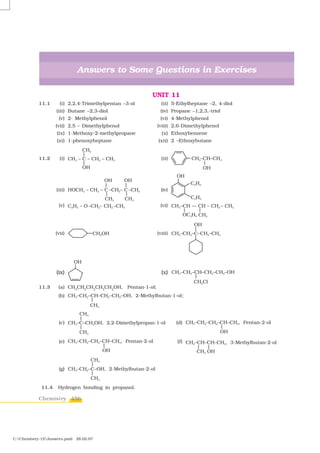
Answers
- 1. Answers to Some Questions in Exercises UNIT 11 11.1 (i) 2,2,4-Trimethylpentan –3-ol (ii) 5-Ethylheptane –2, 4-diol (iii) Butane –2,3-diol (iv) Propane –1,2,3,-triol (v) 2- Methylphenol (vi) 4-Methylphenol (vii) 2,5 – Dimethylphenol (viii) 2,6-Dimethylphenol (ix) 1-Methoxy-2-methylpropane (x) Ethoxybenzene (xi) 1-phenoxyheptane (xii) 2 –Ethoxybutane 11.2 (i) (ii) (iii) (iv) (v) (vi) (vii) (viii) (ix) (x) 11.3 (a) CH3CH2CH2CH2CH2OH, Pentan-1-ol; (b) ; (c) (d) (e) (f) (g) 11.4 Hydrogen bonding in propanol. Chemistry 456 C:Chemistry-12Answers.pmd 28.02.07
- 2. 11.5 Hydrogen bonding between alcohol and water molecules. 11.8 o-Nitrophenol is steam volatile because of intramolecular hydrogen bonding. 11.12 Hint: Carryout sulphonation followed by nucleophilic substitution. 11.13 (i) (ii) (iii) 11.14 Reaction with (i) sodium and (ii) sodium hydroxide 11.15 Due to electron withdrawing effect of nitro group and electron releasing effect of methoxy group. 11.20 (i) Hydration of Propene. (ii) By nucleophilic substitution of –Cl in benzyl chloride using dilute NaOH. (iii) C 2 H5 MgBr + HCHO → C 2 H5CH 2OMgBr C 2 H5CH2OH H2 O → (iv) 11.23 (i) 1-Ethoxy-2-methylpropane. (ii) 2-Chloro-1-methoxyethane. (iii) 4-Nitroanisole. (iv) 1-Methoxypropane. (v) 1-Ethoxy-4,4-dimethylcyclohexane. (vi) Ethoxybenzene. UNIT 12 12.2 (i) 4-Methylpentanal (ii) 6-Chloro-4-ethylhexan-3-one (iii) But-2-enal (iv) Pentane-2,4-dione (v) 3,3,5-Trimethylhexan-2-one (vi) 3,3-Dimethylbutanoic acid (vii) Benzene –1,4-dicarbaldehyde 12.3 (i) (ii) (iii) (iv) (v) (vi) 457 Answers... C:Chemistry-12Answers.pmd 28.02.07
- 3. (vii) (viii) 12.4 (i) Heptan-2-one (ii) 4-Bromo-2-methylhexanal (iii) Heptanal (iv) 3-Phenylpropenal (v) γ-Cyclopentanecarbaldehyde (vi) Diphenylmethanone 12.5 (i) (ii) (iii) (iv) (v) (vi) 12.6 (i) (ii) (iii) (iv) (v) 12.7 (ii), (v), (vi), (vii): Aldol condensation. (i), (iii), (ix) Cannizaro reaction. (iv), (viii) Neither. 12.10 2-Ethylbenzaldehyde (draw the structure yourself ). 12.11 (A) CH3CH2CH2COOCH2CH2CH2CH3, butyl butanoate. (B) CH3CH2CH2 COOH (C) CH3CH2CH2CH2OH. Write equation yourself. 12.12 (i) Di-tert-butyl ketone < Methyl tert-butyl ketone < Acetone < Acetaldehyde (ii) (CH3)2CHCOOH < CH3CH2CH2COOH < CH3CH(Br)CH2COOH < CH3CH2CH(Br)COOH (iii) 4-Methoxybenzoic acid < Benzoic acid < 4-Nitrobenzoic acid < 3,4-Dinitrobenzoic acid. 12.17 (i) (ii) (iii) (iv) (v) (vi) (vii) (viii) (ix) (x) (xi) 12.19 The compound is methyl ketone and its structure would be: CH3COCH2CH2CH3 Chemistry 458 C:Chemistry-12Answers.pmd 28.02.07
- 4. UNIT 13 13.1 (i) 1-methylethanamine (ii) Propan-1-amine (iii) N-methyl-2-methylethanamine (iv) 2-methylpropan-2-amine (v) N-methylbenzamine or N-methylaniline (vi) N-Ethyl-N-methylethanamine (vii) 3-Bromoaniline or 3-Bromobenzenamine 13.4 (i) C6H5NH2 < C6H5NHCH3 < C2H5NH2 < (C2H5)2NH (ii) C6H5NH2 < C6H5N(CH3)2 < CH3NH2 < (C2H5)2NH (iii) (a) p-nitroaniline < aniline < p-toluidine (b) C6H5NH2 < C6H5NHCH3 < C6H5CH2NH2 (iv) (C2H5)3N > (C2H5)2NH > C2H5NH2 > NH3 (v) (CH3)2NH < C2H5NH2 < C2H5OH (vi) C6H5NH2 < (C2H5)2NH < C2H5NH2 UNIT 15 15.1 Polymer is a high molecular mass macromolecule consisting of repeating structural units derived from monomers. Monomer is a simple molecule capable of undergoing polymerisation and leading to the formation of the corresponding polymer. 15.2 Natural polymers are high molecular mass macromolecules and are found in plants and animals. The examples are proteins and nucleic acids. Synthetic polymers are man-made high molecular mass macromolecules. These include synthetic plastics, fibres and rubbers. The two specific examples are polythene and dacron. 15.4 Functionality is the number of bonding sites in a monomer. 15.5 Polymerisation is a process of formation of a high molecular mass polymer from one or more monomers by linking together of repeating structural units with covalent bonds. 15.6 Since the unit — NH–CHR–CO— is obtained from a single monomer unit, it is a homopolymer. ( )n 15.7 On the basis of molecular forces present between the chains of various polymers, the classification of polymers is given as follows. (a) Elastomers (b) Fibres (c) Thermoplastics and (d) Thermosetting plastics. 15.8 In addition polymerisation, the molecules of the same or different monomers add together to form a large polymer molecule. Condensation polymerisation is a process in which two or more bi-functional molecules undergo a series of condensation reactions with the elimination of some simple molecules and leading to the formation of polymers. 15.9 Copolymerisation is a process in which a mixture of more than one monomeric species is allowed to polymerise. The copolymer contains multiple units of each monomer in the chain. The examples are copolymers of 1,3-butadiene and styrene and 1, 3-butadiene and acrylonitrile. 15.10 15.11 A thermoplastic polymer can be repeatedly softened on heating and hardened on cooling, hence it can be used again and again. The examples are polythene, polypropylene, etc. A thermosetting polymer is a permanent setting polymer as it gets hardened and sets during 459 Answers... C:Chemistry-12Answers.pmd 28.02.07
- 5. moulding process and cannot be softened again. The examples are bakelite and melamine- formaldehyde polymers. 15.12 (i) The monomer of polyvinyl chloride is CH2=CHCl (vinyl chloride). (ii) The monomer of teflon is CF2=CF2 (tetrafluoroethylene). (iii) The monomers involved in the formation of bakelite are HCHO (formaldehyde) and C6H5OH (phenol). 15.14 From the structural point of view, the natural rubber is a linear cis-1,4- polyisoprene. In this polymer the double bonds are located between C2 and C3 of isoprene units. This cis-configuration about double bonds do not allow the chains to come closer for effective attraction due to weak intermolecular attractions. Hence, the natural rubber has a coiled structure and shows elasticity. 15.16 The monomeric repeat unit of Nylon-6 polymer is: [NH–(CH2) 5–CO] The monomeric repeat unit of Nylon-6,6 polymer is derived from the two monomers, hexamethylene diamine and adipic acid. [NH–(CH2)6–NH-CO–(CH2)4–CO] 15.17 The names and structures of monomers are: Polymers Monomer Names Monomer Structures (i) Buna-S 1,3-Butadiene CH2=CH–CH=CH2 Styrene C6H5CH=CH2 (ii) Buna-N 1,3- Butadiene CH2=CH–CH=CH2 Acrylonitrile CH2=CH CN (iii) Neoprene Chloroprene (iv) Dacron Ethylene glycol OHCH2–CH2OH Terephthalic acid 15.18 The monomers forming the polymer are: (i) Decanoic acid HOOC – (CH2)8 – COOH and Hexamethylene diamine H2N(CH2)6 NH2 (ii) 15.19 The following are the equations for the formation of Dacron. Chemistry 460 C:Chemistry-12Answers.pmd 28.02.07